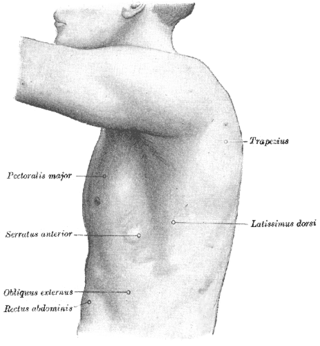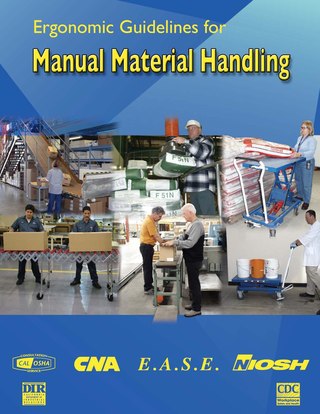Related Research Articles

Scoliosis is a condition in which a person's spine has a sideways curve. The curve is usually "S"- or "C"-shaped over three dimensions. In some, the degree of curve is stable, while in others, it increases over time. Mild scoliosis does not typically cause problems, but more severe cases can affect breathing and movement. Pain is usually present in adults, and can worsen with age. As the condition progresses, it may impact a person's life and hence, can also be considered a disability.

The trapezius is a large paired trapezoid-shaped surface muscle that extends longitudinally from the occipital bone to the lower thoracic vertebrae of the spine and laterally to the spine of the scapula. It moves the scapula and supports the arm.

The scapula, also known as the shoulder blade, is the bone that connects the humerus with the clavicle. Like their connected bones, the scapulae are paired, with each scapula on either side of the body being roughly a mirror image of the other. The name derives from the Classical Latin word for trowel or small shovel, which it was thought to resemble.

The brachial plexus is a network of nerves formed by the anterior rami of the lower four cervical nerves and first thoracic nerve. This plexus extends from the spinal cord, through the cervicoaxillary canal in the neck, over the first rib, and into the armpit, it supplies afferent and efferent nerve fibers to the chest, shoulder, arm, forearm, and hand.
Professional wrestling throws are the application of professional wrestling techniques that involve lifting the opponent up and throwing or slamming them down. They are sometimes also called "power" maneuvers, as they are meant to emphasize a wrestler's strength. Many of these moves are used as finishers by various wrestlers, who refer to them by several different names that reflect their gimmick. Moves are listed under general categories whenever possible.
Professional wrestling holds include a number of set moves and pins used by performers to immobilize their opponents or lead to a submission. This article covers the various pins, stretches and transition holds used in the ring. Some wrestlers use these holds as their finishing maneuvers, often nicknaming them to reflect their character or persona. Moves are listed under general categories whenever possible.

Kyphosis is an abnormally excessive convex curvature of the spine as it occurs in the thoracic and sacral regions. Abnormal inward concave lordotic curving of the cervical and lumbar regions of the spine is called lordosis. It can result from degenerative disc disease; developmental abnormalities, most commonly Scheuermann's disease; Copenhagen disease, osteoporosis with compression fractures of the vertebra; multiple myeloma; or trauma. A normal thoracic spine extends from the 1st thoracic to the 12th thoracic vertebra and should have a slight kyphotic angle, ranging from 20° to 45°. When the "roundness" of the upper spine increases past 45° it is called kyphosis or "hyperkyphosis". Scheuermann's kyphosis is the most classic form of hyperkyphosis and is the result of wedged vertebrae that develop during adolescence. The cause is not currently known and the condition appears to be multifactorial and is seen more frequently in males than females.

Thoracic outlet syndrome (TOS) is a condition in which there is compression of the nerves, arteries, or veins in the superior thoracic aperture, the passageway from the lower neck to the armpit, also known as the thoracic outlet. There are three main types: neurogenic, venous, and arterial. The neurogenic type is the most common and presents with pain, weakness, paraesthesia, and occasionally loss of muscle at the base of the thumb. The venous type results in swelling, pain, and possibly a bluish coloration of the arm. The arterial type results in pain, coldness, and pallor of the arm.

Klumpke's paralysis is a variety of partial palsy of the lower roots of the brachial plexus. The brachial plexus is a network of spinal nerves that originates in the back of the neck, extends through the axilla (armpit), and gives rise to nerves to the upper limb. The paralytic condition is named after Augusta Déjerine-Klumpke.

Erb's palsy is a paralysis of the arm caused by injury to the upper group of the arm's main nerves, specifically the severing of the upper trunk C5–C6 nerves. These form part of the brachial plexus, comprising the ventral rami of spinal nerves C5–C8 and thoracic nerve T1. These injuries arise most commonly, but not exclusively, from shoulder dystocia during a difficult birth. Depending on the nature of the damage, the paralysis can either resolve on its own over a period of months, necessitate rehabilitative therapy, or require surgery.

The position of at attention, or standing at attention, is a military posture which involves the following general postures:
The core or trunk is the axial (central) part of an organism's body. In common parlance, the term is broadly considered to be synonymous with the torso, but academically it also includes the head and neck. Functional movements are highly dependent on this part of the body, and lack of core muscular development can result in a predisposition to injury. The major muscles of the core reside in the area of the belly and the mid and lower back, and peripherally include the hips, the shoulders and the neck.

A winged scapula is a skeletal medical condition in which the shoulder blade protrudes from a person's back in an abnormal position.

Squatting is a versatile posture where the weight of the body is on the feet but the knees and hips are bent. In contrast, sitting involves supporting the weight of the body on the ischial tuberosities of the pelvis, with the lower buttocks in contact with the ground or a horizontal object. The angle between the legs when squatting can vary from zero to widely splayed out, flexibility permitting. Another variable may be the degree of forward tilt of the upper body from the hips. Squatting may be either full or partial.

The neutral body posture (NBP) is the posture the human body naturally assumes in microgravity. Adopting any other posture while floating requires muscular effort. In the 1980s, NASA developed the Man-System Integration Standards (MSIS), a set of guidelines based on anthropometry and biomechanics, which included a definition of an average typical NBP created from measurements of crew members in the microgravity environment onboard Skylab. Still photographs taken on Skylab of crew members showed that in microgravity, the body assumed a distinguishable posture with the arms raised, the shoulder abducted, the knees flexed with noticeable hip flexion, and the foot plantar flexed.

Ergonomic hazards are physical conditions that may pose a risk of injury to the musculoskeletal system due to poor ergonomics. These hazards include awkward or static postures, high forces, repetitive motion, or short intervals between activities. The risk of injury is often magnified when multiple factors are present.

Forward head posture (FHP) is an excessively kyphotic (hunched) thoracic spine. It is clinically recognized as a form of repetitive strain injury. The posture can occur in dentists, surgeons, and hairdressers, or people who spend time on electronic devices. It is one of the most common postural issues. There is a correlation between forward head posture and neck pain in adults, but not adolescents.
References
- ↑ Scott Moses. "Costoclavicular Maneuver". Family Practice Notebook. Archived from the original on 2006-07-19.
- ↑ "Physical Therapy Corner: Thoracic Outlet Syndrome". NISMAT. Archived from the original on 2006-06-25.
- ↑ "Military Brace Test". Liz Dornbos. Hope College Department of Kinesiology. Archived from the original on 2006-09-15.
- ↑ Abigail Brown. "Tips". Spasmodic Torticollis Recovery Clinic. Archived from the original on 2009-06-08.